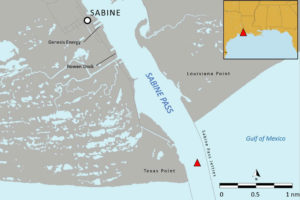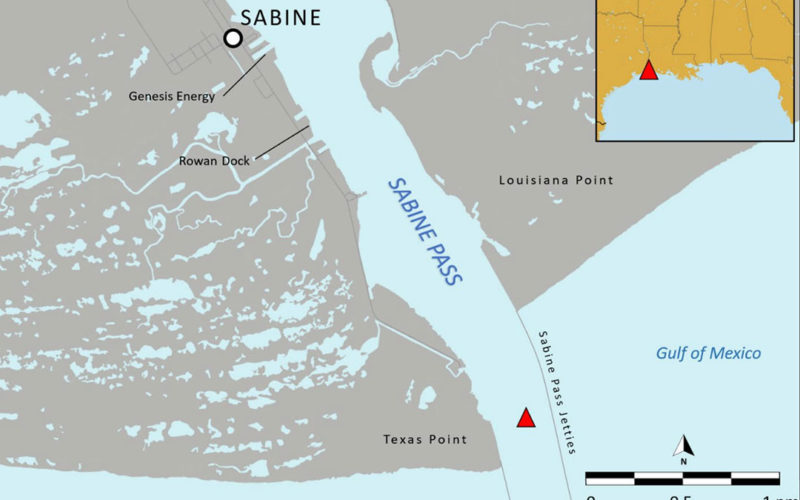
The mate piloting an outbound offshore supply vessel in Sabine Pass steered erratically and ignored crew warnings in the minutes before a collision with an articulated tug-barge (ATB), federal investigators said.
The mate helming the supply boat tested positive for alcohol after the incident, although authorities could not say conclusively that he was impaired during the accident voyage.
The 167-foot Cheramie Bo Truc No. 22, worth $1.2 million, was totaled in the crash with the inbound ATB Mariya Moran/Texas, a 580-foot-long ATB that sustained more than $650,000 in hull damage, the National Transportation Safety Board (NTSB) said in its accident report.
The collision happened near Texas Point within the Sabine Pass Jetty Channel at 0415 on Nov. 14, 2019. No injuries were reported among the five crewmembers on Cheramie Bo Truc or the nine crewmembers and one Sabine Pilot aboard Mariya Moran.
The mate’s abrupt turn to starboard across the ATB’s bow was the immediate, probable cause of the collision, the NTSB said. But poor communication contributed to the accident, which the NTSB said might have been avoided had personnel aboard the 6,000-hp Mariya Moran communicated their intention to meet Cheramie Bo Truc starboard to starboard.
“Although both vessels were aware of each other, no VHF radio passing arrangement or maneuvering signals were made,” the report said. “Inland Navigation Rules require either a port-to-port passage or communication either by radio or whistle signal for an agreed-upon alternate passage between two vessels.”
“A radio call from the ATB prior to the pilot relieving the mate to confirm the offshore supply vessel’s intentions may have kept the Cheramie Bo Truc No. 22 mate from steering across the ATB’s bow,” the report continued.
Cheramie Bo Truc’s voyage appeared troubled from the start. After leaving the Genesis Energy dock at 0352 and entering the channel, the mate tried to use the autopilot feature in the busy waterway but was unsuccessful. “As a result, he struggled to maintain a safe course during the first 12 minutes of the passage, nearly striking a stationary jack-up before returning to manual steering,” the report said.
To avoid the rigs on the west bank, the supply vessel turned to port at a near right angle at 0400, then followed the channel’s east side. Minutes later, the vessel went back to the west side and passed a pilot boat port to port. It stayed on the west side until reaching a bend near buoy 27 at 0412, then crossed the channel again to the east side, the report said.
The inbound Moran Mariya/Texas was about a mile ahead. As the vessels approached, the able seaman on watch reported seeing the approaching ATB. The mate acknowledged, “That’s a ship.”
On the Mariya Moran/Texas, the chief mate and pilot had completed a master/pilot exchange. The pilot checked in with vessel traffic service and he acknowledged being advised of the outbound Cheramie Bo Truc. The ATB maintained a course in the center of the channel at 8 knots, the report said.
Jacob Frisbie, a senior deputy pilot with the Sabine Pilots, told investigators he first saw the Cheramie Bo Truc’s masthead lights about a mile away, maintaining a course on the east side of the channel. He said this was common for vessels heading east after the jetties and not unusual to meet starboard to starboard.
At about 0414, the able seaman and engineer on Cheramie Bo Truc saw the mate start to turn starboard. They warned him to come left instead to avoid the Mariya Moran/Texas but were ignored.
About 23 seconds before the collision, the Mariya Moran/Texas pilot hailed, “Come in on Cheramie Bo Truc.”
“Bo Truc. Go ahead,” the mate said.
“Hey Capt. … you see me?” the pilot said.
“Yes, sir, uh-oh, [expletive]. Hold on. Uh-yeah, hold on,” the mate said.
The collision happened 12 seconds later. Texas’ bow rammed into Cheramie Bo Truc at nearly a right angle, making contact aft of the superstructure, the report said. The force of impact threw the mate helming the supply boat from his chair. The vessel’s no. 1 and no. 2 fuel tanks breached, allowing roughly 6,600 gallons of diesel to escape into the waterway.
Post-casualty saliva swab test showed the mate’s blood alcohol concentration was at least 0.02 grams per deciliter. But because the swab test does not provide the actual blood alcohol content, investigators said the test can only indicate the mate drank beforehand, and is not conclusive that he was impaired by alcohol. The regulatory limit for commercial mariners is 0.04 g/dl.
“However, attempting to use the autopilot in a channel, nearly colliding with stationary jack-ups, weaving across the channel, ignoring the warnings from the on-watch AB and engineer in the wheelhouse, and suddenly turning in front of the ATB all indicate a degree of misjudgment, impairment, and/or incompetence.”
Investigators noted that although the AB and engineer corrected the mate’s erratic steering twice during the voyage before his sudden turn, they did not summon the captain.
“Safe and effective navigation is not one person’s job,” the report advised. “Bridge resource management includes the concept of teamwork, which is an essential defense against human error. A good team should anticipate dangerous situations and recognize the development of an error chain. If in doubt, team members should speak up or notify a higher authority.”
Authorities did not name the Cheramie Bo Truc mate. Its operator, L&M Botruc LLC, did not respond to a request for comment. Moran Towing Corp. declined to comment.

